We have considered disassembling the rear axle gearbox in the article – Disassembling the rear axle gearbox
Before assembly, wash the gearbox parts in kerosene and inspect them.
Check the condition of the teeth of the main gear.
Damage to at least one tooth (chipping, scoring of the working surface) is unacceptable.
Use fine-grained sandpaper to eliminate minor damage to the satellite axle, the necks of the axle gears and their mounting holes in the differential box.
If there is serious damage to the parts, replace them with new ones.
If even minor damage to the surfaces of the support washers of the axle gears is detected, the washers must be replaced (with a selection of the thickness of the washers).
The bearings of the pinion gear and the differential box must be free of wear, with smooth working surfaces.
Poor condition of bearings is the cause of noise and jamming of gear teeth.
We press the inner rings of the differential box bearings with separators and rollers onto the box using a suitable piece of pipe.
We secure the driven gear on the differential box.
When assembling the differential, we lubricate the axle shaft gears with support washers and satellites with transmission oil and install them in the differential box.
We turn the satellites and axle shaft gears so as to align the axis of rotation of the satellites with the axis of the holes in the differential box, and insert the satellite axis.
The axial clearance of each axle shaft gear should not exceed 0.1 mm.
If the clearance is increased, replace the support axle gear washers with new ones — thicker.
The torque of resistance to rotation of the differential gears should not exceed 14.7 Nm (1.5 kgf.m) — the gears can be turned by hand.

Checking the ease of rotation of the differential gears

Using a tool head (a piece of pipe) of a suitable diameter, press the outer ring of the front bearing into the crankcase socket.
Similarly, press the outer ring of the rear bearing.
The correct position of the drive gear relative to the driven one is ensured by selecting the thickness of the adjusting ring installed between the end of the drive gear and the inner ring of the rear bearing.
When replacing the main pair of the gearbox or the bearings of the drive gear, select the adjusting ring.
For this, we make a device from the old drive gear: weld a plate of length to the gear 80 mm and grind the plate to a size of 50-0.02 mm relative to the end face of the gear (the plane of contact of the adjusting ring).
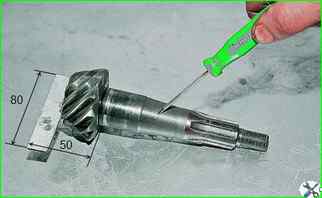
We grind (or process with fine sandpaper) the place where the rear bearing is installed on the drive gear so that the inner ring of the bearing is installed with a sliding fit.
We install the inner ring of the rear bearing with a separator and rollers on the manufactured device and insert the device into crankcase.
Then we install the inner ring of the front bearing with the separator and rollers and the flange of the drive gear.
Turning the gear by the flange to correctly install the bearing rollers, tighten the flange mounting nut with a torque of 7.9-9.8 Nm (0.8-1.0 kgf.m).
Fix the crankcase on the workbench so that its mating plane is horizontal.
Install the template ruler in the bearing bed with its edge so that the touch of the ruler of the beds occurs along the line.

Using a set of flat feeler gauges, we determine the gap between the ruler and the device plate.
We determine the thickness of the adjusting ring by the difference between the gap and the deviation from the nominal position of the new gear (taking into account the sign of the deviation).
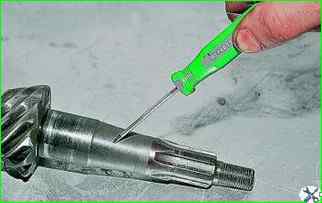
Open mark deviation from the nominal position (in hundredths of a millimeter with plus or minus signs) is marked on the conical part of the gear shank
For example, the measured gap is 2.90 mm, and the gear has a deviation from the nominal position of 15.
Convert the deviation to millimeters: -15x0.01 = -0.15.
The required thickness of the adjusting ring will be: 2.90 - (-0.15) = 3.05 mm.
Install the adjusting ring of the required thickness on the new drive gear.
Remove the device from the gearbox housing and remove the inner rings of the front and rear bearings with separators and rollers.
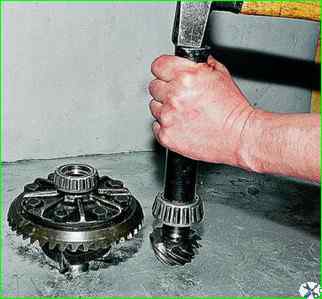
Using a suitable piece of pipe, press the inner ring of the rear bearing with a separator and rollers onto the new drive gear.
Insert the drive gear into the gearbox housing.
Install a new spacer sleeve, the inner ring of the front bearing with a separator and rollers, and an oil deflector.
After lubricating the working edge of the new oil seal with Litol-24 grease, press it into the socket crankcase.
Install the pinion flange.

After locking the flange, gradually tighten the nut that secures it with a torque wrench to 118 Nm (12 kgf/cm).

We control the preliminary tension of the pinion bearings with a dynamometer, periodically checking the moment of resistance of the bearings to the rotation of the pinion.
To do this, tightly wind a strong thread around the flange neck in several turns and attach a dynamometer to it.
If the moment of resistance to rotation is less than 157 Nm (16 kgf.m) - for new bearings, and for bearings after 30 km of run - less than 39.2 Nm (4 kgf m), then tighten the flange fastening nut, not exceeding the tightening torque.
After this, we again check the moment of resistance to rotation of the pinion.
If the moment of resistance is more than 197 Nm (20 kgf m) — for new bearings, and for worn-in bearings — more than 59.0 N m (6 kgf m), then the bearing preload is exceeded.
In this case, it is necessary to replace the excessively deformed spacer sleeve with a new one and reassemble and adjust.
We install the differential assembly with bearings and adjusting nuts in the gearbox card so that they touch the outer rings of the bearings.
We tighten the bearing cap bolts to the required torque.
We make a special key for tightening the adjusting nuts from a steel plate 49.5 mm wide and 3-4 mm thick.
We adjust the lateral clearance in the engagement of the main gear gears and the preload of the differential box bearings simultaneously, in several stages.
We tighten left adjusting nut (from the side of the driven gear) until the gap in the engagement of the main gear gears is completely eliminated.

Using a caliper, measure the distance between the bearing caps
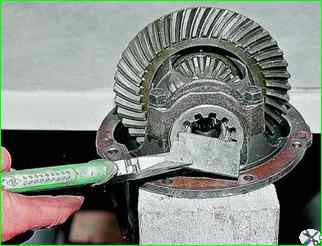
Tighten the left adjusting nut (from the side of the driven gear) until the gap in the engagement of the main gear gears is completely eliminated.
Tighten the right nut until it stops and tighten it by 1-2 teeth of the nut
Tightening the left nut, we set the required lateral clearance of 0.08-0.13 mm in the engagement of the main gear gears.
With this gap, rocking the driven gear, we feel with our fingers the minimum play in the engagement of the gears, accompanied by a slight knock of tooth on tooth.
When tightening the nuts, the bearing caps of the differential box diverge, and the distance between them increases.
To set the preliminary tension of the differential box bearings, sequentially and evenly
Tighten both bearing adjusting nuts until the distance between the covers reaches 0.15-0.20 mm.
Having set the bearing preload, in, we finally check the lateral clearance in the engagement of the main gear gears, which should not change.
To do this, slowly turning the driven gear three times, we check the play in the engagement of each pair of teeth with our fingers.
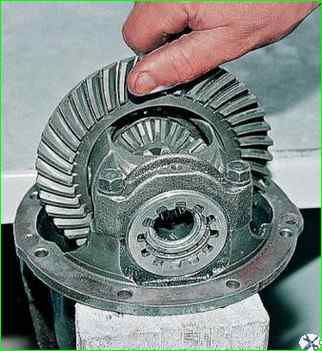
If the clearance in the engagement is greater than required (0.08-0.13 mm), then by turning the adjusting nuts we bring the driven gear closer to the driving one or move it away if the clearance less.
To maintain the set preload of the bearings, we move the driven gear by tightening one of the adjusting nuts and loosening the other by the same angle.
After adjustment, we install the locking plates of the adjusting nuts and secure them with bolts.





